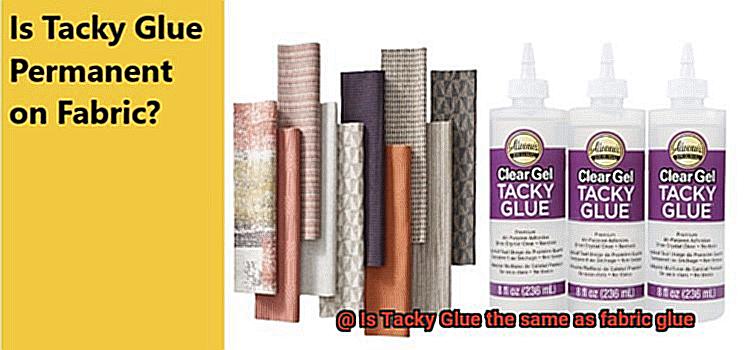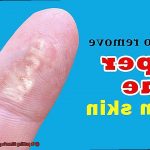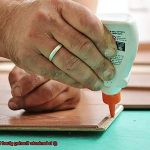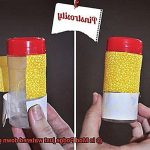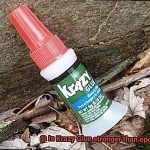Are you in the middle of a crafting project and suddenly realize that you don’t have any fabric glue left? Or are you simply curious about the difference between tacky glue and fabric glue? If so, you’re not alone. Many crafters have found themselves in this predicament, wondering if they can use one instead of the other.
In this blog post, we’ll explore the world of adhesives and answer the question: is tacky glue the same as fabric glue? We’ll examine each adhesive’s ingredients, applications, and properties to determine whether they can be used interchangeably or if using each product for its intended purpose is crucial.
We’ll also highlight the strengths and weaknesses of both tacky glue and fabric glue to help you make an informed decision about which one to use for your next crafting or sewing project.
So let’s dive into the fascinating world of adhesives and discover whether tacky glue and fabric glue are truly interchangeable.
What is Tacky Glue?
Contents
Are you tired of waiting for traditional white glue to dry and not providing a strong enough hold for your crafting projects? Fear not, as tacky glue is here to save the day. This adhesive has become a popular choice among crafters and DIY enthusiasts due to its strong bond and quick-drying properties.
So, what exactly is tacky glue? It is a type of PVA glue that has been specially formulated with added ingredients to make it thicker and stickier than traditional white glue. This makes it a reliable adhesive that can handle a wide range of materials such as paper, wood, fabric, and even some plastics.
One of the benefits of tacky glue is its versatility. It can be used in many different types of crafting and DIY projects, from attaching fabric to other surfaces to securing embellishments like beads or sequins. Additionally, when it dries, it becomes water-resistant, which makes it perfect for outdoor projects or items that may come into contact with water.
But how does tacky glue differ from other types of adhesives? While both fabric glue and tacky glue are similar at first glance, they are designed for different purposes. Fabric glue is specifically formulated for use on fabrics and can be machine washed, making it ideal for clothing and other washable items. Tacky glue, on the other hand, is not designed for use on fabrics and may result in a stiff finish if used inappropriately.
When working on a crafting project that involves fabrics or other specific materials, it’s important to choose the right type of adhesive. Using the wrong type of glue may result in an inferior finished product or even damage to your materials.
What is Fabric Glue?
Fabric glue is the answer to all your crafting needs. As an expert on the subject, let me tell you everything you need to know about this magical adhesive.
Fabric glue is a specially designed adhesive that is meant to bond fabrics together. It is a versatile alternative to traditional sewing methods that can be used for a wide variety of projects. From hemming pants to attaching patches and even creating costumes, fabric glue can do it all. Plus, it’s perfect for delicate fabrics that can be easily damaged by needles and thread.
What makes fabric glue so great is how quick and easy it is to use. With fabric glue, you can create a strong bond between fabrics in just a few seconds. This is a huge advantage over traditional sewing techniques, which can take hours and often require significant skill and precision.
There are several types of fabric glue available on the market, each with its own unique properties. Water-soluble glues are perfect for projects that require easy washing out of clothing. Heat-activated glues require an iron or other heat source to activate the adhesive, making them ideal for more permanent bonds. And if you’re worried about the glue showing through your fabric, there are also clear fabric glues available.
Differences between Tacky Glue and Fabric Glue
One significant contrast between these two adhesive options is their intended use. Tacky glue is a versatile adhesive that can be used on multiple surfaces such as paper, cardboard, wood, and plastic. In contrast, fabric glue is specifically designed for fabrics like cotton, denim, and felt. So, if you’re working on a fabric-based project, it’s best to go for fabric glue.
Another factor to consider when choosing between these two glues is their drying time. Tacky glue can take up to 24 hours to dry clear, while fabric glue dries much faster and can set in as little as 30 minutes. This could be a critical difference when working under tight deadlines.
The ingredients used in the two glues also differ. Tacky glue usually consists of a combination of PVA and water, while fabric glue often contains PVA and acrylic resins to create a stronger bond with fabrics. This means that fabric glue may work better for projects that require a more durable hold.
Lastly, it’s essential to note that some fabric glues are washable while others are not. If you’re working on a project that will be exposed to water or heavy use, it’s best to choose a washable fabric glue that will hold up over time.
Uses of Tacky Glue
Tacky glue may seem like a simple adhesive, but it is actually a crafting powerhouse with countless uses. As an expert in the field, I am thrilled to share some of the most popular and creative ways to use tacky glue in your crafting and DIY projects.
Paper crafts are one of the most common uses for tacky glue. Its strong hold and quick drying time make it ideal for attaching layers of paper and embellishments without warping or wrinkling your paper. From scrapbooking to card making, this adhesive is a must-have for any paper crafter.
But that’s not where its versatility ends. Tacky glue can also be used in woodworking projects as an alternative to traditional wood glue. It bonds well to a variety of surfaces, including wood, metal, and plastic, making it a valuable tool in any DIY project. Whether you’re building a piece of furniture or repairing a wooden frame, keep some tacky glue on hand.
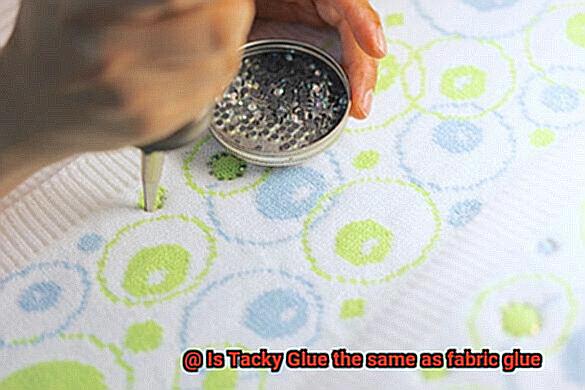
Fabric projects are often associated with fabric glue, but tacky glue can also be an effective adhesive for certain fabrics and embellishments. Be sure to test it on a small area first to avoid any damage or discoloration. With its ability to bond to various surfaces, tacky glue is perfect for attaching fabric to other materials in your DIY projects.
Finally, tacky glue can be used to add personality and texture to your home decor projects. Whether you’re attaching beads or sequins to picture frames or creating unique designs on vases or candle holders, this reliable adhesive won’t let you down.
Uses of Fabric Glue
As an expert on the uses of fabric glue, let me tell you all about this versatile adhesive that will revolutionize the way you work with fabrics.
Fabric glue is an adhesive specifically designed to bond fabrics together, making it a useful tool for anyone who enjoys sewing, crafting, or repairing clothing items. Available in both liquid and stick form, fabric glue can be used on a wide range of fabrics, including cotton, denim, silk, and wool.
One of the most common uses for fabric glue is hemming clothing items. Instead of struggling with a needle or sewing machine, simply apply a small amount of fabric glue to the edge of the fabric and press it down for a secure bond. This is especially helpful for delicate fabrics that may be damaged by sewing.
But that’s not all – fabric glue is also perfect for attaching embellishments to clothing items. Whether you’re adding sequins, beads, or other decorative elements to a shirt or dress, fabric glue provides a quick and easy solution. Simply apply a small amount of glue to the back of the embellishment and press it onto the fabric.
In addition to repairing clothing items, fabric glue can also be used for crafting projects. It can be used to attach fabric to other surfaces such as paper or cardboard or create three-dimensional objects by bonding multiple pieces of fabric together. And if you’re not into sewing, fabric glue is perfect for creating no-sew projects like pillows or curtains.
Advantages of Using Tacky Glue
As an expert in the crafting world, I can confidently say that tacky glue is a game-changer for any project. Here are just a few of the amazing advantages of using tacky glue:
Versatility is key when it comes to crafting, and tacky glue delivers in spades. Whether you’re working with paper, fabric, or wood, this adhesive can handle it all. No more switching between different types of glue for different materials – tacky glue does it all.
Another major advantage of tacky glue is its quick-drying time. You won’t have to wait around for ages for the glue to set – just apply and go. This also means you can avoid any accidental smudging or smearing while you work. And once it’s dry, you can trust that it will stay in place – tacky glue provides a strong and durable bond that will last.
Ease of use is also a huge plus with tacky glue. Its thick consistency means you won’t have to deal with drips or spills, and it can be applied directly from the bottle or with a brush. This makes it perfect not only for experienced crafters but also for kids or anyone who’s new to crafting.
Parents can breathe easy knowing that tacky glue is non-toxic and safe for children to use. No need to worry about harmful chemicals when your little ones are getting creative.
Overall, there’s no denying that tacky glue is an essential tool in any crafter’s arsenal. Its versatility, quick-drying time, ease of use, non-toxic nature, and strong bond make it an ideal choice for projects big and small. So why not give it a try on your next crafting adventure? You won’t be disappointed. Don’t forget these incredible benefits:
Advantages of Using Fabric Glue
Look no further than fabric glue – the versatile adhesive that can transform the way you work with fabrics. As an expert, I can attest to the many advantages of using fabric glue, including:
- Ease of use: With fabric glue, you don’t need any specialized skills or equipment. Simply apply the glue to the desired area, press the fabric together, and let it dry. It’s that easy.
- Fast drying: Unlike traditional sewing methods, fabric glue dries quickly. This means you can finish your project in no time, even if you’re on a tight deadline.
- No need for sewing: Even if you’re not an expert at sewing or don’t have access to a sewing machine, fabric glue can be a great alternative. It creates a strong bond without the need for stitching.
- Flexibility: Fabric glue is flexible and won’t stiffen your fabric or make it uncomfortable to wear. This makes it perfect for use on clothing, as well as other fabrics like upholstery.
- Washability: Most fabric glues are washable, which means you can use them on items that need to be laundered. This is especially important for clothing, where spills and stains are common.
- Versatility: Fabric glue can be used for a variety of projects, from hemming pants to repairing tears and holes, or even attaching embellishments like sequins and beads. The possibilities are endless.
Disadvantages of Using Tacky Glue
It’s easy to use, flexible, and fast-drying, but using it on fabrics can come with some serious disadvantages.
Firstly, tacky glue can leave a visible residue or stain on fabrics. This is especially true for delicate fabrics or when the glue is applied in large quantities. The last thing you want after spending hours creating a beautiful embellishment is to find an unsightly mark left behind by the glue.
Another disadvantage of using tacky glue on fabrics is that it may not be strong enough to hold heavier materials together. Your project can fall apart if the adhesive isn’t strong enough. When working with fabrics, it’s best to choose an adhesive designed specifically for the material you’re using.
Tacky glue can also dry out quickly, making it difficult to work with. If the glue dries out, it loses its adhesive properties and becomes brittle, causing your project to fall apart. To prevent this, make sure to keep the lid tightly closed and store the glue in a cool, dry place.
Lastly, tacky glue may not be suitable for certain types of fabrics or materials. For example, it may not adhere well to synthetic fabrics or materials with a slick surface like leather or vinyl. This limitation can impact the types of projects that can be made using tacky glue and require crafters to use different types of adhesives for different materials.
kOSHpn3HAmQ” >
Conclusion
In summary, it’s essential to understand that Tacky Glue and Fabric Glue are not interchangeable. Each product has been designed for specific purposes, and using the right adhesive will ensure a successful outcome.
Tacky glue is an all-purpose adhesive that can bond a wide range of materials, including paper, wood, fabrics, and even some plastics. On the other hand, fabric glue has been created explicitly for use on fabrics and can withstand machine washing, making it ideal for clothing and other washable items.
While both adhesives may appear similar at first glance, they differ in their intended use, drying time, ingredients used, and washability. Therefore it’s crucial to select the appropriate adhesive when working on crafting projects involving fabrics or other specific materials to avoid inferior finished products or damage to your materials.
Tacky glue is perfect for woodworking projects, paper crafts, fabric projects (after testing on a small area), and home decor projects. Fabric glue is great for hemming clothing items and attaching embellishments to clothing items as well as creating no-sew pillows or curtains.
Both adhesives have their pros and cons; however, they provide fast-drying solutions with strong bonds that make them indispensable tools in any crafter’s toolbox.

